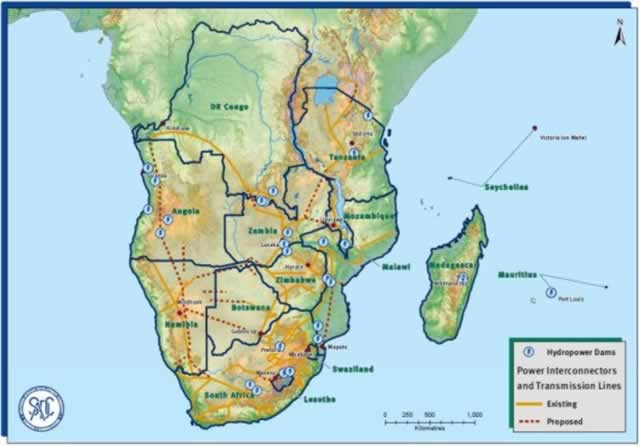Energy alternatives answer for Sadc

Zvamaida Murwira Senior Reporter
Experts say it is time to consider investment in solar and wind technology as alternative sources of energy in the wake of reduced hydro and thermal power generation spawned by poor rainfall distribution that has swept across the entire Sadc region.
Challenges related to hydro power comes amid the construction of an $80 billion Grand Inga Dam in the Democratic Republic of Congo, touted as the world’s largest hydro-power scheme aimed at developing a power grid across Africa through production of 40 000 Mega Watts of electricity that will spur the continent’s industrial economic development.
Engineering Council of Zimbabwe chairperson Engineer Martin Manhuwa said there should be a drive to promote efficient and sustainable use of energy resources which achievable through appropriate pricing policies that provided incentives for renewable energy.
He said there was need to adjust prices in a phased manner that ensures cost recovery and creditworthiness of enterprises to enable them to access domestic and foreign capital markets to finance their expansion, while protecting vulnerable groups through targeted subsidies.
Eng Manhuwa said renewable energy policies in Sadc did not emphasise on research and innovation for renewable electricity generation, fuel production, heating and cooling.
“These activities will address Sadc’s shared societal, industrial and environmental interests to develop sustainable economies. Research to better understand and address the interfaces between different societal challenges such as assuring food security, fighting pandemic diseases, managing climate change, promoting inclusive information societies, and activities aligned with the global sustainable development agenda are lacking in the Sadc region,” said Eng Manhuwa who is also vice president of the World Federation of Engineering organisations.
“African countries struggle with financing of renewable energy projects but clear independent power producers policies and the mindset change to make policies that make investment in solar water heaters and photo-voltaics compulsory in new buildings and in retrofits will create consumers who are producers of electricity, hence easing the demand on the national grid.”
Erratic rainfall experienced in the region over the years has plunged the landlocked southern African region into darkness as countries have resorted to load-shedding to conserve the little available power.
South Africa has remained shoulders above other regional countries in terms of investment, leaving it as the only country that has managed to repel the effects of poor rainfall distribution but it has not gone unscathed.
Meteorologists and climate change experts converged in Kinshasa, Democratic Republic of Congo, in August this year for the 19th Southern African Regional Climate Outlook Forum and predicted that the region was likely to receive inadequate rainfall in the forthcoming season running from October this year to March next year.
Southern Africa Power Pool co-ordination centre manager, Dr Lawrence Musaba said investment in renewable energy was the way to go in wading off the effects of drought that ultimately impeded on power generation.
“Renewable energy is growing in SAPP. This has been more significant in South Africa where the renewable energy programme has been quite successful with Independent Power Producers playing a critical role,” said Dr Musaba.
As a short term strategy, Dr Musaba said, there was need for countries in the region to enhance trade of energy to make up for the other’s deficit.
“”SAPP has a platform for members to trade power on a short term and long term basis. This helps members that are affected by drought to be assisted by those members who would be in a way okay from a generation point of view.
“SAPP is also carrying out demand aside management programmes to manage demand in the advent of a generation shortfall,” he said.
Former Energy and Power Development Minister Engineer Elias Mudzuri said the only way for Zimbabwe and the region to ensure sustainable development was to harness the natural resources such as coal and gas.
He said the use of solar and wind though prudent, created another challenge in that apart from it being seasonal, the sun was only available during the day while there was need to research if Zimbabwe and the region could generate enough wind.
He said there was also need to research on the sustainability and viability of the use of solar and wind by industry.
“You cannot plunge into wind as a source of energy without studies to establish its adequacy and availability in sufficient velocity, the same with solar because it is seasonal and only available during the day. Your investment might not be consistent with production. That is why wind energy is used more in areas adjacent to seas,” he said Eng Mudzuri in an interview.
Eng Mudzuri, who is also Warren Park legislator, said there was need to ensure that solar energy could be stored in adequate measures overnight to ensure sustainability.
Brussels-based director of Global Energy Policy, Dr Steven Singer said renewable energy was increasingly becoming an integral component for sustainable development.
He commended South Africa for taking a huge step in addressing issues of energy.
“South Africa is poised to overtake German, Italy soon with its successful domestic solar power programme. Clean renewable energy deployment is no longer a luxury, costly, ineffective tool of the rich.
The overall question remains not as to whether but as to how fast this is happening. And here massive political intervention by the entire clean energy community is needed,” said Dr Singer.
One senior executive at Zesa Holdings bemoaned huge debt of $1 billion owed to the power utility by consumers as one reason impeding on expansion of power generation by firm.
“In our current environment it is very difficult to bank a project. Zesa is owed $1billion what does it say about the electricity market in Zimbabwe. Would you want to put your money if you were an investor?” he pointed out.
Zimbabwe is one of those countries in the region that has not made meaningful investment in power generation particularly on alternative sources of energy.
This has seen it on the receiving end as it has introduced drastic measures to conserve the little available electricity, further weakening its objectives in implementing Government’s economic blue-print, Zim-Asset, which is of the pillars of economic recovery.










Comments